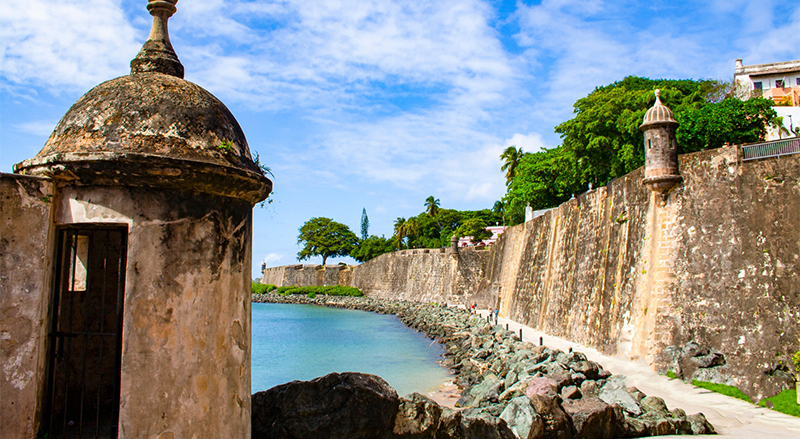Sitting on the northern coast of the island, Old San Juan, is rich in history, culture, and color that whisks the visitors to a different time and place. The city has beautiful, cobbled pathways, colonial-style architecture with old-age pastel colors, and strong-walled castles built hundreds of years ago which make for a perfect walk around the islands while learning all about the Spanish times and Caribbean beauty. Here’s a look into what these wonderful views have to offer while walking around some of the important places in the city which enhance the experience of Old San Juan.
El Capitolio reveals the heritage of Puerto Rico
Begin on your journey at El Capitolio in Puerto Rico. The Capitol building located beyond Old San Juans borders. Built during the 1920s to serve as the seat of the islands assembly this stunning architectural wonder represents more than just a governmental edifice; it stands as a testament, to Puerto Rican heritage and strength. Featuring a architecture of white marble adorned with towering columns marble archways and a majestic dome that pays homage to traditional European influences.
The rotunda, within the Capitol showcases mosaics and frescoes illustrating Puerto Ricos progression from the Taino civilization to its current modern state through the colonial times—a captivating insight, into the islands rich history filled with exhibits presenting significant documents and artifacts that shed light on Puerto Ricos political development. As you explore further from this vantage point overlooking the Atlantic Ocean awaits a view setting the stage for the awe inspiring sights to come ahead.
San Cristóbal Fort: Exploring Colonial Defenses
Walking into Old San Juan, you’ll find San Cristóbal Fort, which bears a testimony to the key significance of the island in the colonial period. This one, which was constructed in 1783, was designed to protect against terrestrial assaults and is the largest Spanish edifice of its type in the Americas. It is an area of 27 acres, has tunnels, dungeons, as well as sentry boxes, which was used to hide the soldiers defending the city, previously.
Walk through the many rooms and hallways of the the fort and let each one bring to life a part of the history of Puerto Rico’s military. Take a view and look over the walls where the cannon aimed at arriving ships in the 18th century and try to fathom being a soldier in the present age guarding this fort. While there are also professionally guided tours available that explain more of the history and construction of the fort, as well as many of the stories behind the soldiers, engineers, and townspeople who relied on San Cristóbal for defense. The first thing to notice about San Juan is that the fort sits on a hill that offers clear views of the Atlantic Ocean and the city’s new and sleek skyline which is a great contrast to the aged fort.
Calle del Cristo: A pictorial tour of the social history of time
Exiting San Cristóbal visit Calle del Cristo one of the most celebrated avenues in the old town of San Juan. This is a colourful wide seventeenth-century cobblestone avenue with pale pastel grey buildings for storeys and iron balconies with flowers cascading down them and ornamental street lamps. The features of its architecture specifically recall the Spanish colonial period, but the bright colors are tropically charged.
It also contains numerous historic sites, shops, shops and cafes, art galleries, thus creating an excellent platform to enjoy your time in walk. Sitting on Calle del Cristo, La Casa Blanca is a whitewashed colonial mansion built for Juan Ponce de León’s family. Its gardens have native vegetation and trees that make a good escape from the dense traffic of the street; a place to appreciate the great works of architecture and horticultural designs of Old San Juan.
San Juan Cathedral: Building upon Puerto Rico’s Unfinished Architecture
A little further along Calle del Cristo are the relatively well-preserved ruins of the San Juan Bautista Cathedral, an important religious and architectural site. It was constructed in 1521 and is still standing making it one of the oldest building in the whole city of San Juan and the second oldest Cathedral in a New World. Walk through to appreciate the incorporation of To đithic and Neo-Classical styles which characterised by high ceilings, art glass and a wooden carved altar.
Many tourists visiting the cathedral are attracted by the tomb of Juan Ponce de Leon, the first governor of Puerto Rico and the famous adventurer looking for the sources of youth. His burials here in this holied ground is a telling of his persona in the Puerto Rican history. Sea is calm and nothing at first impresses people as strongly as stunning details like relics of Saint Pio and the beautiful ceiling paintings. It is a wonderfully peaceful area to sit and take a break and putting you in mind of the initial period of the Spanish colonization in the Caribbean islands.
El Convento: Colonial Grandeur Meets Modern Luxury
To the left of the cathedral is Hotel El Convento, transformed from a Carmelite convent of the XVII century into a luxurious hotel. From its vase coloured building, wrought iron entrance and the arched doors of El Convento, it looks and feels like an old world charm of San Juan. Due to the remodeling process began in the 1960s, the hotel has kept the colonial appearance: there is a beautiful courtyard with trees towering above.
You can take a look at the Spanish Colonial elements of the hotel with its mosaics, wood beam ceiling, and artwork at El Convento. The interior spaces with a network of courtyards and rooftop terrace with the finest view of the San Juan Bay gives an ambiance that allows one to envision life at the hotel centuries ago. If not for accommodation, do some time to find the bar and have some relaxing cocktail or snack and admire the architectural beauty of this historic building.
Castillo San Felipe del Morro: The Mighty Guardian of San Juan
No visitor to Old San Juan can leave the place without getting to see El Morro, which is one of the greatest symbols of Puerto Rico. This historic construction is an elite example of a 16th-century outpost of Spanish colonialism and military fortification built on the south coast of Puerto Rico, guarding the entrance to San Juan Bay and today is a UNESCO World Heritage site. The imposing walls of El Morro, the large cannons and the sentry towers are all designs of the Spanish people.
Have you ever been in the large complex of the fortification, of which has six tiers of walls, built to resist sea artillery fire? Every level is somewhat different with the dungeons and lookout posts; however, these are breathtakinged view of the ocean and the city beneath. A small museum inside sheds light on this fort and includes worthy mementoes and Audio visuals station for children and elders. This is the kind of place that makes you think of how far the Spanish were willing to go to protect their favored Caribbean settlement.
Paseo de la Princesa: A Scenic Stroll Along the Bay
Begin from the El Morro and come down to Princess Street or the Paseo de la Princesa, a 2-kilometer long avenue of trees beside the San Juan Bay. Back in the 19th century, the paseo features sculptures, fountains, and historic street lamps to give the area a beautiful feel, more especially when at sunset. Here, the most popular attraction is the Raíces Fountain which feature statues that portray Puerto Rico ‘s Indigenous Taino, African and Spanish colonization.
There is street entertainment in Artists and craft makers, musicians performing Puerto Rico music and snacks includes alcapurrias ad empanadillas. This makes this region beautiful as it is a blend of gardens, beautiful views of the bay and a significant convergence of both the local and international community in Puerto Rico to celebrate Puerto Rican culture. At sunset, it becomes specific, beautiful and filled with great jolly which also forms a good experience.
Plaza de Armas: The Heart and Soul of San Juan
Before your tour is over, you should visit Plaza de Armas, which historically has referred to as the main public gathering place in San Juan. Founded as the military parade ground, at present occupying the most beautiful antipode, which is enriched with neoclassical architecture, palms, and statues, the central plaza has always been a meeting place for the inhabitants of the city. The tower and sculptures Four Seasons crowning the square fountain creates the dignity of the place.
On its sides, The Plaza borders San Juan City Hall and La Fortaleza, which is the oldest functioning governor’s residence in Puerto Rico in the whole of the Americas. Take a moment out to appreciate the architecture two and ponder all that one has witnessed and realised that you are at a place inhabitants of San Juan have congregated for more than 400 years. It forms a nice conclusion to the historical trail that you have taken through the Old San Juan.
End with a Feast: Sampling Puerto Rican Cuisine
End your day marinated with some Puerto Rican food. Visit a local restaurant for this tasty delicious meal that is prepared using fried and mashed boiled plantain potatoes filled with either meat, seafood or vegetables. Other recommendations are bacalaitos (crispy codfish fritters), lechón asado (roast pork,) and tostones (fried green plantains.
In Old San Juan most restaurant have outdoor seating where you can eat while watching the street and the architecture of the old buildings. As for the last tasting remember to take something sweet: tembleque – the South American’s coconut pudding; or Piragua – this is an ice stick coated with a layer of chocolate and served by street vendors. Delving into these local delights is the best that is expected to complete your tour, a tour that actually gives a true Puerto Rico.
Final Reflections
Old San Juan is the historic part of the city and a walking tour would involve history, a mix of architecture and culture. Every street, every building, every statue has its story to say and make the residents aware of Puerto Rico’s history and progress. I always say that you can taste the multiple personality disorder of San Juan in every cobblestoned wall, in every smiling face of the people you meet, in every mouthwatering food that you taste. This walk through the beautifully painted streets of Old San Juan will capture the hearts of the travelers and make them to look further into the blend that defines Puerto Rico.

